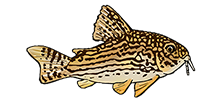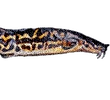/siluriformes/claroteidae/lophiobagrus/sp%281%29/1.jpg)
Shell Lophiobagrus - Lophiobagrus sp. (1)
Article © Max Bjørneskov, uploaded February 15, 2025.
Max Bjørneskov introduces a fascinating new species which is well suited to the hobby and details significant successes with this small rift lake catfish.
Preface
Some years ago (2016) Marta Mierzeńska received some tiny catfish from Michelle Buckland in shipments from Zambia. They were only exported a few times and in total only around 18 specimens came to Kraków. A few were sold, and the rest was used to build a group in a one species aquarium for further studies. These were probably the only specimens ever exported from the Lake. The catfish seemed to be found by coincidence, when the fishermen were looking for Neolamprologus multifasciatus. The few times they came to Poland, it was always together with these shell dwelling cichlids. They are only known from the Nsumbu area, where they always live in shell beds at relative shallow water. Today, the wild caught specimens are still alive. After a few have been sent to Germany and Denmark, the breeding group holds around 15 - 20 specimens. In the aquarium they breed now and then, always with one or two fry at a time.
The genus Lophiobagrus
The genus Lophiobagrus was described by Poll in 1942. Poll gave the genus its name because the broad, depressed anterior part of the fish reminded him of the anglerfish Lophius piscatorius. Today there are four described species.
- Species of Lophiobagrus in 2025
- Lophiobagrus aquilus Bailey & Stewart, 1984 (80 mm).
- Lophiobagrus asperispinis Bailey & Stewart, 1984 (34 mm) The description is based on juvenile specimens.
- Lophiobagrus brevispinis Bailey & Stewart, 1984 (62 mm).
- Lophiobagrus cyclurus (Worthington and Ricardo, 1937) (61 mm), originally described as Chrysichthys cyclurus.
Generally, these four species are found in relatively shallow water in rocky areas with lots of hiding places in the cracks and crevices. They are found in Zambia and Burundi. Most likely future surveys will expose Lophiobagrus species at other places and probably more undescribed species as well. The described species are all quite small, but compared to Lophiobagrus sp. “Shell” which is just around 30mm (the biggest female in my group is 35mm) thy others are bigger. Bailey & Stewart write that Lophiobagrus appears to have specialized through maturation at a small size to occupy small interstices of the littoral rock-rubble. Brichard (1989, page 468) noted that when confined to a tank, Lophiobagrus exudes a sticky, transparent mucus which mixes with the water and kills other fish they are housed with.
The aquarium
In January 2023, Marta Mierzeńska kindly sent me a small group of Lophiobagrus sp. “Shell” for further observation. I had prepared an 84-liter aquarium (60 x 40 x 35 cm) with a thin layer of sand and a few pieces of rock. To be able to have a closer look at these small catfish in their shells, some Neothauma shells were opened and glued to a piece of glass with silicone for aquarium. In that way they could be placed against the front glass in the desired position. A piece of a thin black plate was placed outside on the front glass and was attached with Velcro. Whether an aquarium like this will take the first prize in an aquascaping contest is doubtful, but it serves its purpose.
/4.jpg) Pair inside Neothauma shell.
Pair inside Neothauma shell.
I received the Lophiobagrus together with some other interesting fish from Lake Tanganyika and began slowly to acclimatize the new fish to their aquariums. The catfish were still in their shells, so I had to get them out somehow, to make them move to the open shells. The shells with the fish were carefully placed upside down near the surface with cable ties. Little by little the catfish could be seen in the shell openings and some hours later, they all had moved to their new shells.
Keeping Lophiobagrus
As always, you must give fish from a certain location some suitable conditions. For Lake Tanganyika fish this means water with a temperature from 23 - 27 °C and a pH value not too low. Here there is around 24 °C and pH a little above 8. About a 25% change of water every week keeps the water in a good quality for the fish. The filtration in the catfish aquarium is very simple - just an HMF-filter at the whole backside of the aquarium. It is divided in halves with a piece of glass vertically in the middle. This gives the opportunity to clean one filter at the time and in this way keep the filtration very stable. The filter is driven with two airlift tubes. Lophiobagrus sp. “Shell” is not difficult to feed. They take a little of everything that fits in size. Here they get different types of dry food, and they seem to prefer small soft granulated pellets, this in combination with some live and some frozen food (Artemia, Cyclops, Daphnia, black and white mosquito larvae) keeps the small catfish in good condition. They are not very greedy but make fast small runs out of their shells to grab some of the food items near their hiding places.
Breeding attempts
Now and then two or even three specimens were seen together in one shell. In March 2023 I noticed the first egg clutch from the biggest female. There were three or four eggs sticking together at the bottom of the Neothauma shell. The female picked up the eggs and swam a little around with them, maybe because of the disturbance from removing the cover in front of the shells. A few moments later she spat them out at the bottom again. Two days later the eggs were gone. The next two spawns also disappeared after few days, but then in July, there was a clutch of five eggs, and they developed nicely. Of the four eggs that hatched one died after a couple of days, but the last three soon began to look like typical catfish larvae. A week later two were still alive and in December they had grown to around 20 mm. It was very interesting to observe the way the female took care of the eggs and larvae. Very often she was in the opening of the shell waving water down to the offspring. Now and then she picked up the eggs, maybe to clean them or maybe to protect them from my disturbances. In nature, maybe a specialized egg eating species like Mastacembelus plagiostomus could try to eat the eggs in the shells. Then they would be perfectly protected in the mouth of the catfish, because these rather small spiny eels wouldn't eat the fish. But this is naturally only speculation. Also, the developing larvae were picked up and carried around for some minutes most of the time I checked what was going on. When the yolk sac was absorbed and the tiny fry began to swim around, there was no aggression from the other adult fish, when the young ones came into their shells. Then, the next several clutches of eggs disappeared after a day or two, which of course was extra frustrating with a fish like this, so I decided to take the next eggs and place them in a so called egg-tumbler, to see if they were fertilized. There were four eggs which all developed nicely, and the small catfish are now swimming in the breeder box growing as they should. Naturally I would prefer the fish to breed and take care of the fry themselves, but with a species, that is very rare in our hobby, I think it is alright to “cheat” a little.
Feeding the young
Generally, it is easy to feed fry from Lake Tanganyika species and Lophiobagrus sp. “Shell” is no exception. They can take Artemia nauplii from the beginning and when this is supplemented with small frozen food like Cyclops and powdered dry food, the fry will grow reasonably well. It can be a good idea to place the fry in a “breeder box”, because then the advantage of a bigger aquarium and the limited space in the box makes it easier to concentrate the food for the fry.
Thank you
Thank you very much to Marta Mierzeńska for letting me work with these small and interesting catfish and for the information about the import from Zambia.
- Literature
- Bailey R. M., Stewart D. J., 1984, Bagrid catfishes from Lake Tanganyika, with a key and descriptions of new taxa, Misc. Publ. Mus. Zool., Univ. Mich., 168: 1-41.
- Brichard P., 1989, Pierre Brichard's Book of Cichlids and All the Other Fishes of Lake Tanganyika, T. F. H. Publications.
Copyright information for the images used in this article can be found on the species' full Cat-eLog page.
| Scientific Name | Lophiobagrus sp. (1) |
| Common Name | Shell Lophiobagrus |
| Etymology | Lophiobagrus: The name comes from the broad, depressed anterior region of the fish, which reminded Poll of the Monkfish (Lophius piscatorius). |
| Articles | |
| Size | 35mm or 1.4" SL. Find near, nearer or same sized spp. |
| General Remarks | Mucus is probably poisonous to other fishes. |
| Distribution | This species was collected in the Nsumbu area in Zambia – Lake Tanganyika. African Waters, Western Rift Valley Lakes, Tanganyika (click on these areas to find other species found there) Login to view the map. |
| IUCN Red List Category | Not Evaluated |
| Feeding | Small crustaceans, black and white mosquito larvae and several types of suitable dry food of decent quality. User data. |
| Furniture | A layer of sand with enough shells scattered on the bottom. Preferably the shells of Neothauma tanganyicense, but other shells of the same size can be used. They live almost exclusively in the shells and are most active nocturnally. |
| Breeding | The female takes care of the few eggs deep inside shells. Document in "Tanganika Magazyn no. 34". |
| Breeding Reports | There is no breeding report. |
| Registered Keepers | There is but a single registered keeper, view all "my cats" data. |
| Wishlists | Love this species? Click the heart to add it to your wish list. There is no wish to keep this species. |
| Spotters | Spotted this species somewhere? Click the binoculars! There are 2 records of this fish being seen, view them all. |
| Forum BBCode | |
| Search for L. sp. (1) | |
| Look up L. sp. (1) on AquaticRepublic.com | |
| LFS label creator ARN ref:1.2.140.8920 | |
| Last Update | 2024 Dec 26 14:20 (species record created: 2025 Feb 15 13:34) |
Back to Catfish of the Month index.




